Bug fare at the Bug Fair
May 16, 2012
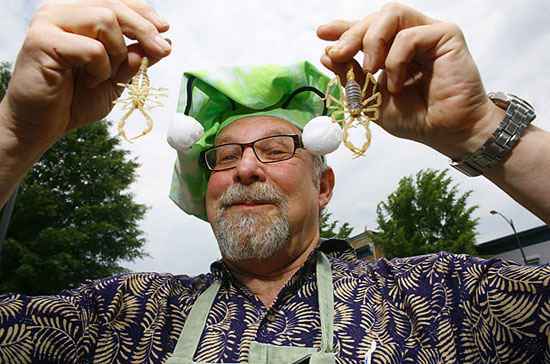
David George Gordon, who won last year's bug cookoff, is an ardent advocate of insect cuisine. Photo/Time
Fancy yourself an adventurous eater? The county’s Natural History Museum has something to challenge your palate at the 26th annual Bug Fair. That’s right—it’s time to grub on grubs.
The “Bug Chef Cook-Off” debuted at last year’s fair, and it’s back again in 2012 by popular demand. Three of the top entomophagists (bug chefs) from across the country are ready to go antenna to antenna with their best bug dishes.
They’re part of a burgeoning bug cuisine movement that’s grabbed the attention of publications including Time and The New Yorker, which have chronicled the efforts of those seeking to make insects palatable as human food for a variety of environmental, ethical and economic reasons.
One of the movement’s stars, David George Gordon, won last year’s cook-off at the museum with tempura-battered tarantula and teriyaki grasshoppers on rice noodles. Gordon, 62, an ardent bug consumption advocate, said hosting the cook-off is a very progressive move by the museum.
“In the United States and Europe it is an uphill struggle,” said Gordon. “Europeans have a bad attitude about bugs. But meat is basically muscle, whether from a tarantula or a cow. Tarantula has a similar texture to crab.”
Gordon, a science writer in the process of updating his Eat a Bug Cookbook, said a trip to Switzerland inspired him to add fondue to this year’s menu (think decadent, chocolate-dipped locusts).
Daniella Martin, the brains behind the Girl Meets Bug blog, is on her own mission to bring critter cuisine to the public. Her YouTube videos offer step-by-step instructions on how to cook and eat things like wax worm tacos and fried scorpion.
The third contestant is David Gracer, 47, of Rhode Island. He is the founder of Small Stock Foods, a company that arranges educational programs, bug tastings, bug catering and bug food sales. He has appeared on “The Colbert Report” and the “Tyra Banks Show” to promote human consumption of bugs. According to Gracer, the reasons to eat insects are both environmental and culinary.
“It’s a good way of dealing with overpopulation by conserving our water and food resources,” said Gracer. “On the other hand, there is also the adventure and fun of eating something new. When you eat insects you are eating closer to nature.”
Gracer’s dishes will feature wax worms, Ugandan katydids (“surprisingly rich, they taste a lot like crispy French fries”) and a surprise ingredient—maybe giant ants, he said.
In addition to competition dishes, the chefs plan on providing courageous attendees with free samples, like Gordon’s famous Chirpy Chex Party Mix. (The “chirpy” part, as you may have guessed, is roasted crickets.)
The Bug Fair, which bills itself as the biggest bug festival in North America, will provide plenty of other entertainment, too—entertainment that doesn’t involve eating or watching other people eat bugs.
The theme for Bug Fair 2012 is the “Year of the Fly,” and if that conjures thoughts of biting horseflies or pesky gnats, museum curator of entomology Dr. Brian Brown wants a chance to change your perspective.
“A few bad apples like mosquitoes that have ruined our thinking about flies,” said Brown. “Most are neutral or beneficial to humans.”
For example, Brown will be presenting “flower flies,” which look a lot like wasps or bees. Brown said flower flies are important pollinators that also feast on aphids— the small, plant-devouring pests that are the bane of gardeners everywhere. Brown also said the flies are a popular subject for amateur naturalists who have moved beyond the most popular species like birds and butterflies.
Other attractions at the event include bug pinning demonstrations, bug-sniffing dogs, specimen handling opportunities and “Supersized Insect Walkabouts”—costumed performances that include a giant monarch butterfly on stilts. The museum and its insect exhibits will also be on display, along with a related special exhibition of jewel-encrusted butterfly brooches in the Gem and Mineral Hall.
The Bug Fair runs from 9:30 a.m. to 5 p.m. on Saturday, May 19, and Sunday, May 20. Tickets are $12 for adults, $9 for seniors and students, $8 for youth ages 13 to 17 and $5 for children ages 5 to 12. Kids under 5 are free. Parking is $8 or $10 in adjacent lots, but attendees may opt to try Metro’s new Expo Line, which has two stops just a short walk from the museum.

Out of the frying pan and into the belly? Maybe, if the eating public decides that bugs are food. Photo/Time
Posted 5/16/12
Bike Week’s cycle of celebration
May 10, 2012
Bicycles keep gaining traction in Los Angeles County. With the most recent edition of CicLAvia behind us, it’s time to celebrate pedal power during the 18th Annual Bike Week, May 14-18.
Metro, the Los Angeles County Bicycle Coalition and other community organizations are partnering for five days of bike festivities, beginning Monday with a 10 a.m. kick-off celebration at the University of Southern California’s Galen Center. New initiatives to promote bicycling will be announced at the event.
After that, on Tuesday, clergy of various religions will perform the 9th Annual Blessing of the Bikes at Good Samaritan Hospital from 8 a.m. to 9:30 a.m. Cyclists who attend can also receive the earthly blessings of a free bike check-up and breakfast.
On Wednesday, cyclists can “test pedal” the new Expo Line bike lanes on a mid-city ride, which meets at the Expo Park/USC station at 8 a.m. and departs at 8:30 a.m.
Thursday, May 17, is Bike to Work Day. Metro and other local transit agencies will give free rides to anyone with a bike or a helmet, and local cycling organizations and businesses will host dozens of pit stops with free refreshments and giveaways. After the workday is over, participants can join fellow riders at one of several after parties.
The week concludes on Friday with Bike to School Day, which takes aim at reducing traffic congestion in school zones.
Bike Week will give the public 5 days’ worth of reasons to avoid the hassles of driving while getting some healthy exercise with L.A.’s growing cycling community. To keep safe on the roads, check out these quick tips from Metro.
Posted 5/9/12
What your mother isn’t telling you
May 9, 2012
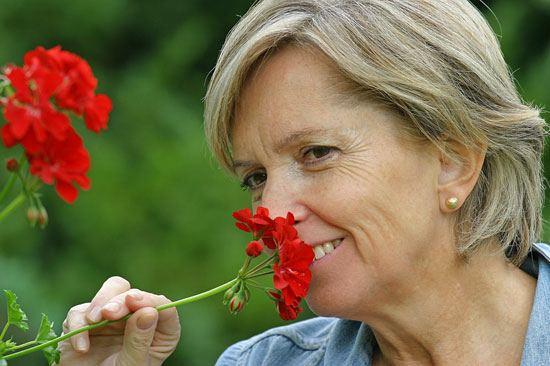
Say it with geraniums this year at the Arboretum, or explore some other Mother's Day options around the county.
She’ll smile, hug you and say thanks—maybe more than once.
She’s your mother, after all. But deep inside, you can’t help wondering whether your time-honored Mother’s Day brunch-and-bouquet routine has Mom thinking you’re just a little bit challenged in the creativity department.
Here’s your chance to change her mind. Los Angeles County facilities are offering a wide range of out-of-the-ordinary diversions to explore this Mother’s Day weekend.
For instance, it’s a great time to check out the 124 acres of the scenic Los Angeles County Arboretum & Botanic Garden. On Saturday and Sunday, May 12 and 13, the International Geranium Society will hold a Mother’s Day Geranium Show. Local hobbyists, enthusiasts and experts will display exotic varieties of the flower, cultivated from plants originating in South Africa. If your mother has a green thumb of her own, show her the new “Garden for all Seasons,” which demonstrates the latest in environmentally friendly, year-round cultivation of fruits and vegetables.
If your mother is a music lover, why not take her to the 9th Annual Mother’s Day Jazz & Blues Extravaganza at the John Anson Ford Amphitheatre? Every seat in the roofed, outdoor venue is no more than 94 feet from the stage and guests are welcome to bring a picnic. Purchase tickets online to save a few bucks.
If mom’s more an Earth mother type, perhaps she’d enjoy an outing to the Natural History Museum (and possibly getting there on Metro’s brand-new Expo Line). In addition to the new Dinosaur Hall (motherhood bonus points: the only known fossil of a pregnant plesiosaur), there’s also Hall of Gems and Minerals and the Insect Zoo to explore, along with the Butterfly Pavilion, which boasts 53 unique living species. For even more bonus points, take a walk down memory lane in the famous Exposition Park Rose Garden, directly to the south of the museum.
Outside these L.A. County offerings, there are other goings-on Mother’s Day weekend, like free babysitting and a spa Friday at UCLA’s Mother’s Week, a family bluegrass jam at the Fowler Museum and card-making and stories at the Craft and Folk Art Museum.
If you absolutely must do the brunch thing, combine it with a trip to lush and rustic Topanga Canyon, where the Will Geer Theatricum Botanicum Mother’s Day event features dance, music and circus performances.
Your mother has eaten eggs, muffins and toast before. She probably hasn’t seen an aerialist perform while she’s eating them. Now is as good a time as any to give her a brand-new experience. What a smart, cultured son or daughter you’ll be!
Posted 5/9/12
LACMA docents mark 50 artful years
May 8, 2012
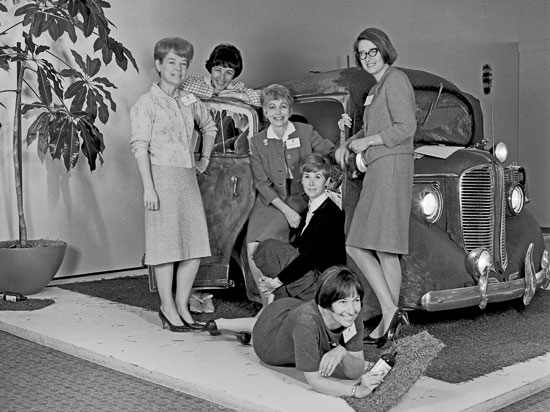
Terry Bell, second from left, and fellow docents defended Kienholz's "Back Seat Dodge '38" in LACMA's early years.
Terry Bell was a 34-year-old homemaker with two children in Westwood when art changed her life.
“It was the early ‘60s, and I had a good friend who did fundraising for the museum,” she remembers. “One day she said, ‘You’re a disgrace! You’re a college graduate and you don’t know anything about painting or sculpture.’ ”
At her friend’s insistence, she signed up for a then-new program to train docents at the Los Angeles Museum of History, Science and Art in Exposition Park, which at the time housed the county’s art collection. Now, 50 years later, she is an avid art collector, a Los Angeles County Museum of Art life trustee and a founding member of one of the largest docent organizations in the nation. She has exposed thousands of visitors to museum treasures, recorded acoustic guides for major exhibitions and worked against the censorship of controversial and important artworks.
And she traces it all to that decision a half-century ago to volunteer as a LACMA docent..
“It is just so rewarding,” says Bell, who this week is among the hundreds of honorees celebrating the golden anniversary of LACMA’s Docent Council. “Not only in terms of yourself, but in what you can give back to the community.”
Some 521 men and women belong to the Docent Council, a volunteer juggernaut whose members have led more than 2 million children and adults through the museum since it became an official entity in 1962.
More than a million Southern California schoolchildren have been led on field trips by LACMA docents; so have generations of adult visitors to the museum’s many exhibitions.
“We are definitely in the front lines,” says Judith Tuch, who chairs the council. “We provide the personal connection between the students and adults who come to the museum and the art they see. For many, it’s the first time they’ve ever been in a museum. For some, unfortunately, it may be the only time they’ll be in a museum.
“We encourage them to understand that this is a county museum, and that this is their place.”
The council grew from a small group of volunteers who explained art during the 1950s at what is now the Natural History Museum. Though visitors at that Exposition Park site mostly came to see dinosaurs and fossils, the county also had quietly been amassing fine art since the 1920s. Members of the Junior League, the Volunteer League of the San Fernando Valley and other local organizations offered informal tours of the gifts from such early donors as William Preston Harrison, Paul Rodman Mabury and William Randolph Hearst.
In 1961, amid planning for a separate Los Angeles County Museum of Art on Wilshire Boulevard, the groups joined forces to create a formal docent training program. Fifty-three women took the special classes in art history and elementary education.
After a provisional year, the Docent Council was officially formed, chaired by Glenn Cooper, a Junior Leaguer who later became a well-known arts patron in Sun Valley. Their goal: To train 200 docents in time for the official opening of LACMA in 1965.
The docents were key almost from the moment the new museum opened. In 1966, for instance, they rose to defend Edward Kienholz’s still-controversial “Back Seat Dodge ’38.” The piece, which depicts a beer-soaked encounter in a parked car, is so sexually charged that members of the then-Board of Supervisors denounced it as pornographic.
“I had met Ed Kienholz and talked to him about the exhibition, and I thought it was terrific,” Bell remembers.
 Eventually, the Supervisors decided the piece could be seen, “but the door to the car couldn’t be open unless a docent was there to explain it,” Bell says, recalling that at one point, she had to tour a group of clergy that included her own rabbi—whom she had to shush with the admonition that she listened to him every week, so he should do her the courtesy of returning the favor.
Eventually, the Supervisors decided the piece could be seen, “but the door to the car couldn’t be open unless a docent was there to explain it,” Bell says, recalling that at one point, she had to tour a group of clergy that included her own rabbi—whom she had to shush with the admonition that she listened to him every week, so he should do her the courtesy of returning the favor.
The piece—like later Kienholz exhibitions that Bell also guided—became a sensation and visitors mobbed the museum. “Five or six of us guided tours every 20 minutes,” Bell remembers, “almost around the clock.”
Since then, the council has grown along with the county in diversity and sophistication. Some 25 members are men and docents of all races, creeds, ages and backgrounds lead tours in multiple languages.
Now overseen by the museum’s Education Department, the group has a training regimen that includes extensive coursework in art history and touring techniques and a 2-year provisional period. No member can tour adults without spending at least 5 years doing school tours.
“We have several attorneys in the current [provisional] class,” says Patsy Palmer, a child psychotherapist and longtime LACMA volunteer who now trains incoming docents. “One man in my group is a retired doctor.” All the new docents, she says, “are highly qualified and uniquely skilled.”
“We’ve come so far,” agrees Bell, who says she can’t wait to see how visitors respond to “Levitated Mass” and other upcoming attractions. “We’re really in a marvelous place.”
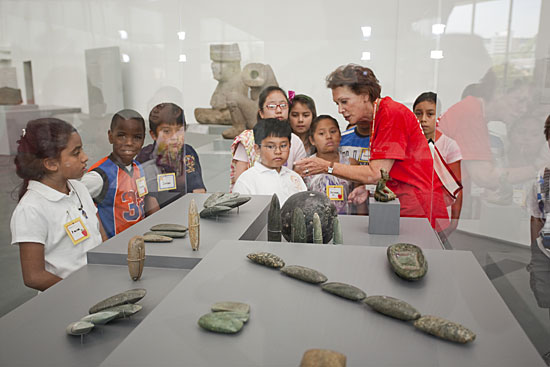
LACMA docent Patsy Palmer has shown the museum to legions of children. The Docent Council turns 50 this week.
Posted 5/2/12
Expo Line’s festive and historic debut
May 2, 2012

The Expo Line rolled into the record books, as the initial phase of the light rail was formally opened on Friday, April 27.
It will run at first between downtown Los Angeles and the La Cienega/Jefferson station, with an opening of the line’s Culver City station planned in coming weeks. The 8.6-mile line was inaugurated with a flourish—complete with tunes from the USC Marching Band, the appearance of huggable T-Rex from the county Natural History Museum, confetti cannons and free rides during Expo’s opening weekend.
Dignitaries including Supervisor Zev Yaroslavsky, chair of the Expo Board, celebrated the historic nature of the occasion, as the first light rail trains since the Red Car made tracks for the Westside. A second phase of the line, which will run to Santa Monica, is now underway.
Posted 5/2/12
Expo’s backstage safety patrol
April 27, 2012
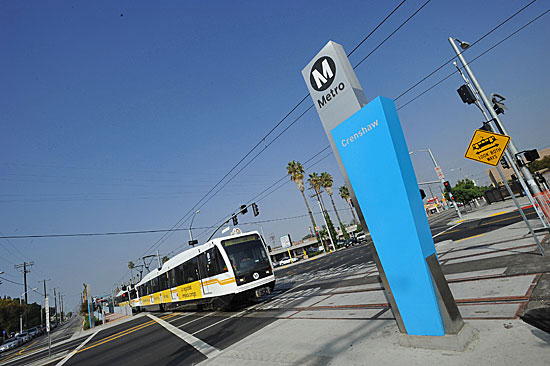
With new Westside rail service, officials want to make sure that trains, cars and pedestrians safely co-exist.
Launch time for the Expo Line means crunch time for Vijay Khawani and Barbara Burns.
With the official opening this weekend of Expo’s first phase, Metro safety and education officials like Khawani and Burns have been working their way down a to-do list that, like the line itself, stretches from downtown to La Cienega.
And then there are the new things that keep cropping up.
Like the guy in the Maserati who ignored flashing signals and almost pulled out in front of an approaching train Tuesday.
Khawani, Metro’s Executive Officer of Corporate Safety, was out on the line with inspectors from the Public Utilities Commission when he spotted the car moving toward the tracks, so he raced down the station ramp toward it, waving his arms and yelling to get the motorist’s attention.
Crisis averted.
Making sure drivers, bicyclists and pedestrians stay alert around the trains—especially while they’re still something of a novelty—is a major preoccupation as Expo gets ready to roll.
Khawani and Burns, manager of Metro’s Transit Safety Education Programs, are key players on a team that must not only ensure that Expo meets all the regulatory requirements but also presents a safe and familiar image to the public in the line’s crucial early days and weeks.
For months, Burns has been deploying a small army of “safety ambassadors”—24 retired bus and rail operators—into communities around the new line to help people navigate the new system and to report back on trouble spots.
“We start one year before any train takes the track,” she said. “In the beginning, it’s always chaotic.”
To educate the public about what’s headed their way, Burns’ team has conducted dozens of training sessions at schools, senior centers and libraries and with neighborhood watch and community groups, sent out hundreds of notices about train testing, put up 4,000 safety posters and handed out 60,000 flyers door to door.
They’ve also placed safety ads on the sides of 20 trains—with bilingual messages such as “Hear bells? See lights? Train’s coming.”
“We started to do it with the Eastside Extension (of the Gold Line) and found it to be very effective,” she said. “It’s like a moving billboard.”
Still, some people don’t get the message. There have been three collisions involving Expo Line trains since testing began—all the result of motorists proceeding against a flashing red light signaling an approaching train, Khawani said. The most recent accident, on April 19, was caused by a driver making an illegal left turn, he said.
“That type of accident is actually the most common type of light rail accident in the industry across the country,” he said. “I think education is a big component because this is something that’s new in the neighborhood. They’ve never had trains.”
Common sense goes a long way, he said. There have been no serious injuries in the Expo crashes, but a brand new Mercedes Benz was totaled on March 19 when its owner got distracted “playing around with the new navigation system,” he said.
“We can’t do it alone,” Khawani said. “They’ve got to obey the signs.”
Large crowds are expected to ride Expo for free on its inaugural weekend, Saturday and Sunday, April 28 and 29. And before the light rail makes its public bow, a series of technical and mechanical fixes have been required.
An automatic routing system to make sure Expo and Blue Line trains—which share some stations in downtown L.A.—get on their respective tracks logged 20 “misroutes” on a recent day of testing.
So at least at the beginning, controllers in Metro’s Rail Control Center (known as “The ROC”) will be routing the trains manually.
“It’s a temporary fix until we can assure ourselves that the automatic routing function is working reliably. It’s not a safety concern, it’s more an operational concern,” Khawani said. “When you’re on a train for Long Beach, you don’t want to end up in Culver City”—an unlikely scenario, he added, because the train operator would almost certainly notice the misroute before reaching the end of the line.
Another major priority is making sure that trains don’t block intersections. That has meant getting the city Department of Transportation to change signal timing to give train operators some extra “green time” to proceed through intersections—first 10 extra seconds and then, as of Sunday, 4 more.
“Four seconds make a big difference,” Khawani said. “Since Sunday, we have not seen any trains blocking any intersections. It has improved it dramatically.”
A test run Tuesday with the PUC inspectors onboard was largely successful, although two signs at the Crenshaw station needed to be relocated so trains can proceed without getting stopped between stations.
At the La Cienega station, Khawani checked to see that emergency lighting required by the L.A. Fire Department was in place and working. (It was, and he snapped a photo with his phone.)
No detail, it seems, is beneath his attention. He called in a mistake he spotted at the Western station, where a pavement sign reading “Stay Behind Yellow Line” was accidentally transposed to read “Yellow Line Stay Behind.”
Animated but apparently unflappable, Khawani has seen 20 years’ worth of launches since he joined Metro. And he says he has never doubted that the Expo Line would open Saturday.
“This is very typical of all openings,” he said. Still, don’t expect him to let his guard down anytime soon. “I don’t think there is ever a time when you get to breathe a sigh of relief.”
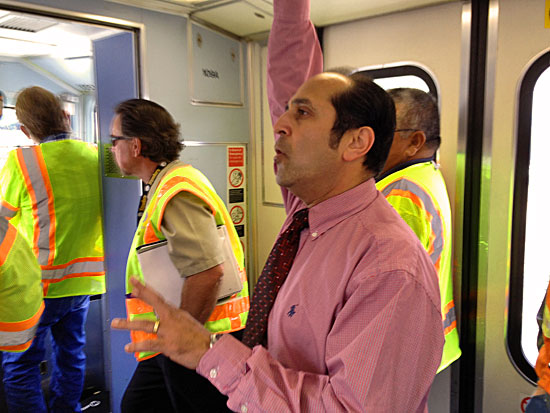
Vijay Khawani, Metro’s Executive Officer of Corporate Safety, rides Expo with safety team and PUC inspectors.
Posted 4/26/12
Searing lessons of the riots
April 26, 2012
It was several hours after the Rodney King verdicts and the city had yet to exhale. Shocked by the police acquittals, I headed to First AME Church with Mayor Tom Bradley and other civic and religious leaders to urge calm. When we stepped inside, the streets were quiet—which is why I was taken aback a short time later by the pictures of fire and violence on a TV reporter’s monitor inside the church.
“Why are you showing the ’65 Watts Riots?” I asked in a challenging tone.
“Councilman,” he said, “that’s a live shot from our helicopter.”
Within moments, I was being accompanied by a church deacon to my city car, parked near the intersection of Adams and Western. “You cannot walk there yourself,” I was told firmly. By then, every window of the vehicle had been smashed out. I was driven home by an aide to Councilman Nate Holden, who represented the area.
Today, 20 years later, images of those cataclysmic days seem as distant as the Watts Riots did to me on that evening at First AME. There’s almost a grainy, historical look to the photos and videos we’ve seen resurrected in recent days, creating a sense that this dark and transformative moment in our history is long behind us.
Yes, many of the conditions that led to the 1992 explosion of lawlessness have been repaired. One of the most significant events in the aftermath of the riots—the Christopher Commission—has led to a Police Department that is now making headlines for its partnership with minority neighborhoods, not for its hostile disrespect towards them. Today, residents in areas once deprived of the most basic commerce have access to supermarkets and businesses, though still not enough.
And imagine, two decades ago, launching a new transit system through some of the most charred stretches of the region, as we’re doing today with the Expo Line.
So when the question is asked—could it happen again?—many of us, thinking with our hearts, want to say no, of course not. But I think that would be naïve and dangerous. Although police brutality may have been the match that lit the fuse, the riots drew fuel from economic conditions that for years bred deep resentment—conditions that persist today.
We have yet to provide credible hope to those on the lower end of the income scale that they can work their way into the middle class. Employment, affordable housing, health insurance, child care, quality education, all these things and more continue to elude families living in communities enveloped by the 1965 and 1992 riots.
Too often, federal, state and local governments responsible for confronting such issues seem more interested in pointing fingers than in finding solutions. At the minimum, we elected officials must talk with the most marginalized among us and hear the challenges in their lives. The lack of such communication was one key reason the Los Angeles power structure was blindsided by the breadth of the unrest. I know this may sound ridiculously basic, but the fact is that it’s harder to ignore a person’s plight once you’ve had a conversation with them.
Today, from my vantage point on the Board of Supervisors, I can confidently state that our local governments have not shrunk from the challenges brought into harrowing relief by the flames of 20 years ago. We’ve funded neo-natal programs and created school-based health centers to make sure people, especially the youngest amongst us, receive the care they need and deserve. We’ve pushed for a “living wage” for workers at the lowest end of the earning scale. We’ve begun to clean the urban environment and create parks in communities that once offered little more than asphalt. And we’ve embarked upon an ambitious rapid transit agenda that will create thousands of jobs and bring rail transportation to neighborhoods that have gone without it for far too long.
All these share this in common: respect for human dignity. So long as we honor that notion and dedicate ourselves to reducing economic disparities, there is hope we can transform the lives of individuals and communities for the better.
Posted 4/27/12
Getting there is all the fun
April 25, 2012
When the first segment of the Expo Line opens Saturday, it will whisk transit patrons to destinations like the Coliseum and the Los Angeles County Natural History Museum. On opening day, riders won’t even need to leave the station platforms for a good time.
Celebrations with live entertainment will be held Saturday, April 28, at four stations—7th/Metro, Expo/USC, Expo/Crenshaw and La Cienega/Jefferson. There will be standard fare including live music, info booths and L.A.’s ubiquitous gourmet food trucks, but there are also a few off-the-beaten-path diversions.
For starters, how about a psychic magician with a cat assistant? The Fantastic Fig and his cat, Newton, have appeared on America’s Got Talent and the Kathy Griffin Show to perform their mind-bending card tricks. On Saturday, the crowds at La Cienega/Jefferson station will get a close look at what the Fig has up his sleeve as he performs a roving routine.
If magic’s not your bag, a professional mime will also be riding the rails, performing on trains and in stations. Artist Tony Duran of the 24th Street Theatre gives silent performances that range from purely comedic to serious and dramatic. Unfortunately, despite multiple attempts, the mime could not be reached for comment.
Alternatively, the inaugural crowds can show off their own abilities via karaoke, which takes place at Expo/Crenshaw and La Cienega/Jefferson stations. The less vocally-inclined might opt instead to memorialize the occasion in photos, using Cirque du Soleil’s “green screen” to transform themselves digitally into virtual Cirque performers, at the 7th/Metro station. In addition, photo booths will be arranged at other stations so patrons can personalize snapshots with props and possibly a map of the new light rail line as a backdrop. Photos will be posted online after the event.
In addition to the sideshows there is, of course, the main event. This weekend, the shiny new Expo Line is the belle of the ball. Free rides will be offered Saturday and Sunday, from 5 a.m. to 7 p.m. After that, the line starts taking on paying customers and will operate from 5 a.m. to midnight.
(During the inaugural run, trains will be bypassing the line’s Farmdale and Culver City stations, which are not yet completed, though they are expected to open in the weeks ahead.)
According to Anna Chen of Metro’s media relations department, the opening day fun is all about the communities Expo will serve.
“We tried to incorporate local talent and promote the businesses and vendors along the line as much as possible,” said Chen. (A look at some of the eateries and other attractions along the line is here.)
Expo is expected to be one of the nation’s most heavily-used light rail lines. A second phase to Santa Monica is now underway.
Posted 4/25/12
Expo wins again in court
April 18, 2012
As the first segment of the Expo Line gets ready to roll later this month, the light rail’s second leg, to Santa Monica, received an important green light this week from a state appeals court, which rejected a challenge to the project’s environmental review process.
The court found that the review was properly conducted to assess the project’s impact on future traffic and air quality. The ruling marks the second rebuff of a legal challenge to the project that was filed by the homeowners’ group Neighbors for Smart Rail. The group filed suit in 2010, but a Los Angeles Superior Court judge rejected its argument last year.
The group had contended that the Exposition Metro Line Construction Authority improperly based its environmental review on projected 2030 conditions instead of using 2009 conditions as a baseline. The group said previous court cases involving projects inSunnyvaleandMaderahad disallowed the use of such hypothetical projections.
But the appeals court said those cases did not apply to Expo.
“In our review of the record, we found the Expo Authority’s use of 2030 projections is supported by both substantial evidence and common sense,” the court said in its opinion.
The court said that it was impractical to look at current conditions in trying to assess how the project would affect traffic and air quality.
“As a major transportation infrastructure project that will not even begin to operate until 2015 at the earliest, its impact on presently existing traffic and air quality conditions will yield no practical information to decision makers or the public,” the court said. “Many people who live in neighborhoods near the proposed light rail line may wish things would stay the same, but no one can stop change.”
Terri Tippitt, president of Neighbors for Smart Rail, said that the court’s ruling is in direct conflict with decisions handed down by other state appeals courts, and her group is planning another appeal.
“The California Supreme Court needs to review and decide what the law is,” she said in a brief statement.
But Expo CEO Rick Thorpe hailed the decision. “The appellate court decision allows us to move forward without delay to this much needed project,” he said. “This is great news for improving mobility on the Westside of L.A.”
Posted 4/18/12




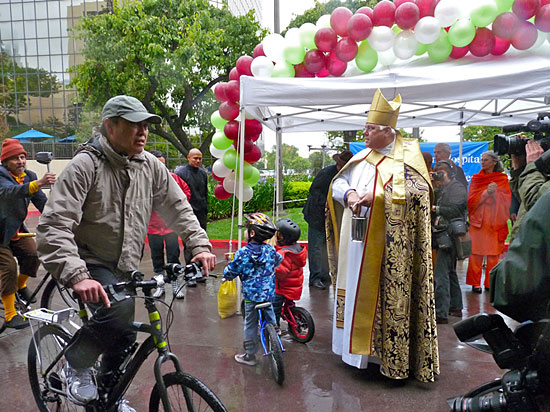
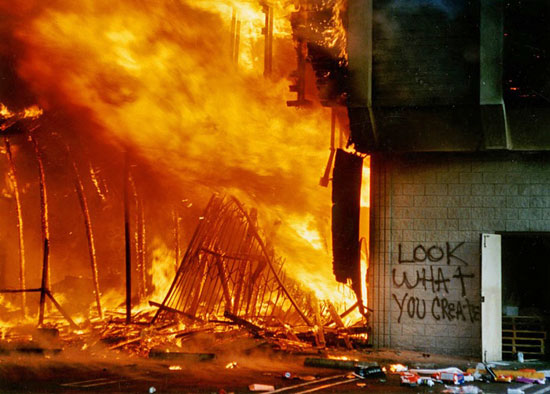
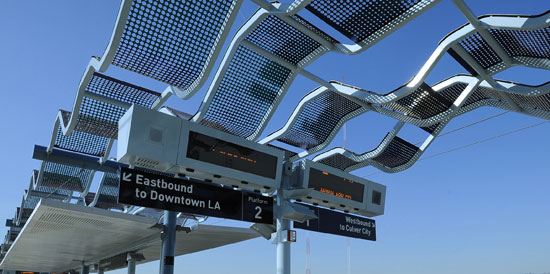
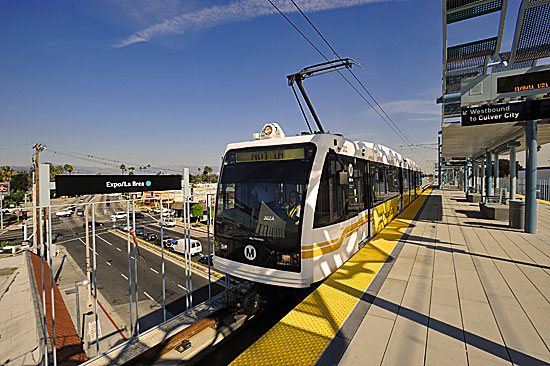







 405 bridge work causes a stink
405 bridge work causes a stink

